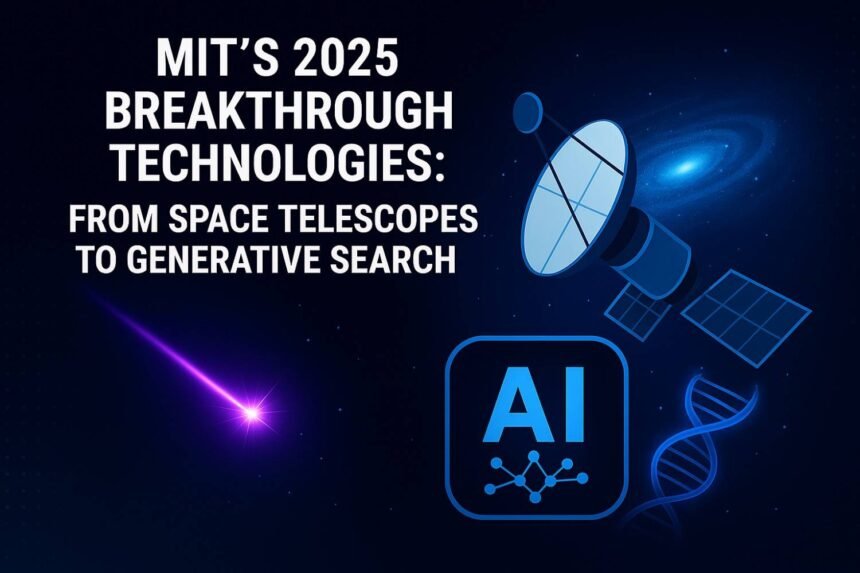Each year, MIT Technology Review publishes its prestigious list of breakthrough technologies that will reshape our world for decades to come. The 2025 edition presents an extraordinary collection of innovations spanning astronomy, artificial intelligence, sustainable aviation, and robotics—technologies that collectively promise to revolutionize how we explore the universe, find information, travel the planet, and interact with intelligent machines. These aren’t distant future concepts but emerging realities poised to deliver transformative impact within the next three to five years.
The Legacy Space Observatory Revolution
Leading MIT’s 2025 breakthrough list is the Vera C. Rubin Observatory, a revolutionary telescope coming online in Chile’s remote Atacama Desert. This astronomical marvel houses the largest digital camera ever constructed for astronomy—a 3.2-gigapixel sensor capable of capturing the entire visible southern sky every few nights for a full decade.
The observatory’s unprecedented survey capabilities will generate more astronomical data than all previous sky surveys combined. Every night, the telescope will capture approximately 20 terabytes of data, creating a time-lapse movie of the universe that will reveal previously invisible cosmic phenomena. Scientists expect to discover millions of new galaxies, asteroids, and variable stars while tracking the subtle movements of celestial objects across vast timescales.
The project’s primary mission focuses on understanding dark matter and dark energy—mysterious components that comprise 95% of the universe yet remain largely unexplored. By mapping how galaxy clusters evolve over time and measuring cosmic expansion rates, the observatory could answer fundamental questions about the universe’s ultimate fate and the nature of reality itself.
Beyond dark matter research, the telescope will transform planetary defense capabilities by cataloging potentially hazardous asteroids with unprecedented completeness. The survey will identify objects as small as 140 meters in diameter—large enough to cause regional devastation if they strike Earth—providing decades of advance warning for potential impacts.
Generative Search: The End of Traditional Web Browsing
Artificial intelligence continues revolutionizing how humans access information, with generative search emerging as perhaps the most transformative development since the original search engine. Unlike traditional search that returns lists of relevant web pages, generative search provides personalized, conversational answers synthesized from multiple sources in real-time.
This technology leverages large language models to understand complex queries, analyze vast information repositories, and generate unique responses tailored to individual users’ needs and contexts. Instead of sifting through dozens of search results, users receive comprehensive answers that incorporate the most relevant information from across the internet.
The implications extend far beyond convenience. Generative search could democratize access to expert knowledge by making complex information accessible through natural language conversations. Students researching scientific topics could receive explanations adapted to their educational level, while professionals could access synthesized insights from industry publications without manually reviewing hundreds of documents.
However, this transformation raises significant concerns about information accuracy and source attribution. Traditional search allows users to evaluate source credibility independently, while generative search relies on AI systems to synthesize and present information without always revealing underlying sources or potential biases.
Sustainable Aviation Fuels: Decarbonizing Flight
The aviation industry faces mounting pressure to reduce its carbon footprint, with sustainable aviation fuels (SAF) emerging as the most promising near-term solution for decarbonizing flight. These alternative fuels, produced from used cooking oil, industrial waste, captured carbon dioxide, and other sustainable feedstocks, can reduce aviation emissions by up to 80% compared to conventional jet fuel.
Unlike previous alternative fuel attempts that required significant aircraft modifications, SAF functions as a “drop-in” replacement for conventional jet fuel, compatible with existing aircraft engines and fuel infrastructure. This compatibility enables immediate deployment without requiring airlines to replace their entire fleets or airports to rebuild fuel systems.
The breakthrough comes not from the fuel chemistry—which has been understood for years—but from scaling production to commercial viability. Multiple facilities worldwide began large-scale SAF production in 2025, with government mandates requiring increasing percentages of sustainable fuel in aviation applications. Airlines are securing long-term supply contracts despite SAF currently costing two to five times more than conventional jet fuel.
Major aviation manufacturers have committed to SAF compatibility across their fleets, while airlines are investing billions in securing sustainable fuel supplies. The industry projects that SAF could provide 65% of the carbon reductions needed to achieve net-zero aviation emissions by 2050, making this technology crucial for the industry’s environmental sustainability.
Robotics Revolution: From Specialized to General Purpose
Artificial intelligence advances are transforming robotics from single-purpose machines into versatile systems capable of learning new tasks rapidly. Modern robots leverage generative AI and large language models to understand instructions, interpret environments, and adapt behaviors without extensive reprogramming for each new application.
This evolution represents a fundamental shift from traditional industrial robots that perform identical tasks repeatedly to intelligent systems that can be deployed in new environments and learn appropriate behaviors through observation and interaction. Recent demonstrations show robots learning household tasks, warehouse operations, and even creative activities through AI-powered learning systems.
The technology’s commercial implications are profound. Instead of requiring specialized robotic systems for each industrial application, companies could deploy general-purpose robots that adapt to multiple tasks within single facilities. This versatility could dramatically reduce automation costs while enabling smaller businesses to access robotic capabilities previously available only to large corporations.
Healthcare applications appear particularly promising, with robots learning to assist with patient care, medication delivery, and facility maintenance tasks. These systems could address healthcare worker shortages while providing consistent, high-quality support services that free human staff for more complex patient interactions.
AI-Powered Scientific Discovery Acceleration
Artificial intelligence is revolutionizing scientific research methodology by automating hypothesis generation, experimental design, and data analysis processes that previously required months or years of human effort. AI systems can now identify patterns in vast scientific datasets, propose novel research directions, and even design experiments to test specific hypotheses.
Drug discovery represents one of the most promising applications, where AI systems analyze molecular structures, predict drug interactions, and identify promising therapeutic compounds exponentially faster than traditional methods. This acceleration could reduce the typical 10-15 year drug development timeline by several years while significantly lowering research costs.
Materials science benefits similarly, with AI systems predicting material properties and designing novel compounds for specific applications like battery technology, solar cells, and superconductors. These capabilities could accelerate the development of clean energy technologies essential for addressing climate change.
Climate science applications leverage AI to analyze massive environmental datasets, improve weather prediction models, and identify optimal strategies for carbon capture and renewable energy deployment. The technology’s ability to process and synthesize information from multiple sources provides insights impossible through traditional research methods.
Educational Technology and Research Integration
The convergence of breakthrough technologies creates unprecedented opportunities for educational advancement and research collaboration. Universities and research institutions worldwide are developing comprehensive programs that integrate space science, AI development, sustainable technology, and robotics into interdisciplinary curricula.
Many academic institutions studying these breakthrough technologies rely heavily on technical presentations, expert lectures, and detailed demonstrations to understand implementation strategies and research methodologies. Research teams developing educational programs around MIT’s breakthrough technologies often need access to high-quality audio content from technical conferences, expert interviews, and research presentations. For universities building comprehensive technology education programs, the ability to youtube video download mp3 320kbps becomes essential for extracting clear audio from technical presentations that can be integrated into educational materials and research documentation systems.
Economic and Societal Impact Projections
The collective economic impact of MIT’s 2025 breakthrough technologies could reach trillions of dollars over the next decade. Space-based research capabilities will drive advances in materials science, communications technology, and Earth observation systems. Generative search will transform how businesses access and utilize information, potentially increasing productivity across knowledge-intensive industries.
Sustainable aviation fuels represent a multi-hundred-billion-dollar market opportunity while addressing one of the most challenging sectors for decarbonization. Advanced robotics could reshape manufacturing, healthcare, and service industries by providing flexible automation solutions that adapt to changing needs and requirements.
The technologies also promise significant societal benefits. Improved asteroid detection capabilities enhance planetary defense, while advanced AI systems could accelerate solutions to climate change, disease, and resource scarcity. However, these advances also raise important questions about employment displacement, privacy, and the equitable distribution of technological benefits.
International Competition and Collaboration
MIT’s breakthrough technologies reflect broader global trends in technological development, with nations competing intensively for leadership in AI, space technology, clean energy, and robotics. The United States maintains advantages in AI research and space technology, while other nations lead in manufacturing capabilities and alternative energy deployment.
International collaboration proves essential for maximizing these technologies’ benefits while addressing shared global challenges. Climate change, asteroid threats, and pandemic preparedness require coordinated international responses that leverage the best technologies regardless of their country of origin.
Trade policies and technology transfer restrictions increasingly influence how breakthrough technologies develop and deploy globally. Nations balance promoting domestic innovation with accessing international expertise and markets necessary for scaling revolutionary technologies.
Implementation Challenges and Timeline
Despite their transformative potential, MIT’s breakthrough technologies face significant implementation challenges. Regulatory frameworks often lag behind technological capabilities, creating uncertainty for investors and developers. Safety standards for AI systems, space technologies, and advanced robotics require careful development to balance innovation with risk management.
Infrastructure requirements for deploying these technologies at scale demand substantial investments in education, manufacturing capabilities, and supporting technologies. Sustainable aviation fuels require new production facilities and supply chains, while advanced robotics need comprehensive safety protocols and workforce retraining programs.
Technical challenges remain significant for each breakthrough technology. Space telescopes must operate reliably in harsh environments for decades, while AI systems require enormous computational resources and careful bias mitigation. Sustainable fuels need cost reductions to achieve widespread adoption, and advanced robots must demonstrate safety and reliability in diverse real-world environments.
Future Technology Convergence
The most profound impacts may emerge from convergence between MIT’s breakthrough technologies rather than their individual applications. Space-based observations could inform AI models for climate prediction, while robotics systems could automate sustainable fuel production. Generative search could accelerate scientific discovery by helping researchers navigate vast literature repositories more effectively.
This technological convergence suggests that the next decade will see accelerating innovation rates as breakthrough technologies amplify each other’s capabilities. Organizations successfully integrating multiple breakthrough technologies may gain significant competitive advantages over those focusing on individual innovations.
Conclusion
MIT’s 2025 breakthrough technologies represent humanity’s bold attempts to address its greatest challenges while expanding the frontiers of knowledge and capability. From peering deeper into the cosmos than ever before to revolutionizing how we find information and travel the planet, these innovations promise to reshape civilization in fundamental ways.
The success of these technologies depends not just on continued technical development but on thoughtful implementation that maximizes benefits while minimizing risks. As 2025 progresses and these breakthrough technologies mature from laboratory demonstrations to real-world applications, their collective impact will likely exceed even the most optimistic current projections.
The future belongs to organizations, nations, and individuals who successfully harness these breakthrough technologies while addressing the ethical, social, and economic challenges they create. MIT’s 2025 list provides a roadmap for the technological transformation ahead—a future that promises to be as challenging as it is extraordinary.
MIT’s 2025 Breakthrough Technologies: From Space Telescopes to Generative Search

Shanky Tanky covers the latest in technology, apps, and digital tools. Follow his updates on Delhi Scanner for smart and practical tech insights.
Leave a Comment Leave a Comment





